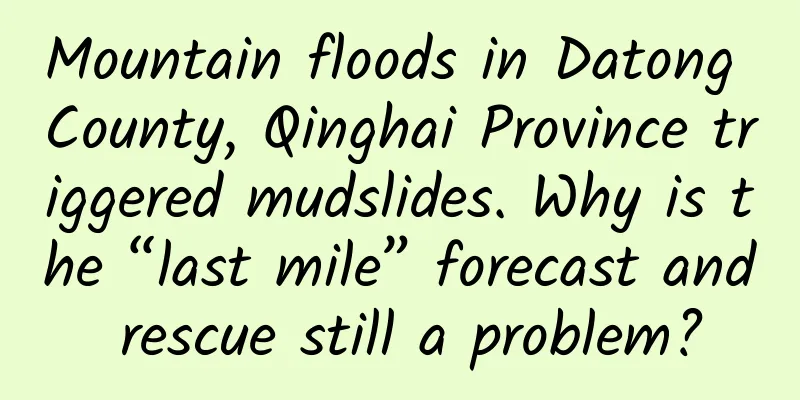Mountain floods in Datong County, Qinghai Province triggered mudslides. Why is the “last mile” forecast and rescue still a problem?

|
Heavy rainfall in Datong County, Qinghai Province, triggered mountain torrents and caused mudslides. Why is mudslide forecasting and rescue still a problem? How should we identify and save ourselves when encountering mudslides? Written by reporter Zhao Tianyu Edited by Ding Lin New Media Editor/Lv Bingxin Interview experts: Li Jing (Member of the National Disaster Reduction Committee, Professor of the Institute of Disaster Reduction and Emergency Management, Beijing Normal University) Zhang Ying (Director of the Science Popularization Committee of Beijing Disaster Reduction Association) The disaster in Datong County, Xining City, Qinghai Province has attracted the attention of the whole society and is worrying. At 22:25 on August 17, a sudden heavy rainfall in Datong County, Xining City, Qinghai Province, triggered mountain torrents, mudslides, and river diversions, affecting 6,245 people in 1,517 households in 6 villages in 2 towns. According to the CCTV News client, as of 20:00 on the 19th, the mountain torrent disaster had caused 23 deaths, 8 people missing, and 23 missing people were rescued. ▲Disaster site in Datong County, Qinghai (screenshot from CCTV News) There are many factors that lead to debris flow, and heavy rainfall is one of the important causes. As the flood season continues to arrive in various parts of the country, it is particularly important to improve the prevention and risk avoidance of debris flow and other related geological disasters. Why is mudslide prediction and rescue still a problem? Debris flow refers to the torrent formed when heavy rain and floods dilute the soft soil of the mountain with sand and rocks. Wherever the debris flow reaches, it can destroy roads and railways at the least, or engulf villages and even towns at the worst, causing serious casualties. If early warning can be achieved, the risk of debris flow will be greatly reduced. However, Li Jing, a member of the National Disaster Reduction Committee and a professor at the Institute of Disaster Reduction and Emergency Management of Beijing Normal University, pointed out that it is still difficult to predict debris flow, especially the "last mile" forecast and warning, which is a technical problem that needs to be solved urgently. ▲Distribution of areas prone to debris flow and landslide in my country (Image source: National Emergency Broadcasting) The formation of debris flow requires the following three conditions to be met at the same time: first, a large amount of water in a short period of time. Heavy rain, melting ice and snow, and the collapse of rivers, lakes, or reservoir dams can all become factors that trigger disasters. During the rainy season in Beijing from the end of July to the beginning of August, severe convective weather occurs frequently during the flood season, and rainfall is the main cause of debris flow. Secondly, the formation of debris flow requires a large amount of loose materials. In addition to the naturally formed loose soil, unreasonable economic activities in mountainous areas and other human factors can also increase the possibility of debris flow. For example, excessive logging of forests and pastures, deforestation and reclamation of land, reclamation of steep slopes, and unscientific mining can all provide material sources for the occurrence of debris flow. Finally, the formation of debris flows also requires special terrain that is conducive to the collection of water and materials. For example, when the slope of the valley is greater than 30°, it is easy to induce collapse, landslides and debris flows. Among the above three factors, topography and geological conditions determine the location and scale of debris flow, and rainfall conditions determine the time of debris flow. These provide certain basic information for the forecast and warning of debris flow. Based on these "clues", in recent years, the meteorological department has cooperated with the Ministry of Water Resources and the Ministry of Land and Resources to issue service products such as mountain torrent meteorological disaster warning and geological disaster meteorological risk warning, which have become an important means to support disaster prevention and mitigation. However, for natural disasters such as debris flow, service products alone are far from enough. Li Jing explained that the current debris flow monitoring and early warning, like the forecast of geological disasters such as volcanoes and earthquakes, is still in a "blind man touching an elephant" state. Some debris flows are gradual, and the early displacement of the mountain may be monitored; but more debris flows are sudden outbreaks, and it is impossible to accurately monitor the activity trajectory inside the mountain rock. In addition, the mountainous area has inconvenient transportation and poor communication, so the "last mile" early warning is the difficulty and shortcoming currently faced. Similar problems also arise in the transfer of personnel. Because the danger points of debris flow are scattered, the potential victims are also scattered. Among the casualties caused every year, some are too late to transfer, some are unwilling to transfer, or return after being transferred, which makes the rescue of debris flow disasters difficult. In addition, it is also not easy to achieve fixed-point and quantitative forecasts for meteorological conditions such as rain. Under complex terrain conditions, the forecast error of precipitation is relatively large, which also poses a great challenge to my country's meteorological forecasts for mountain torrents and geological disasters. "Soft and hard" multi-pronged approach to disaster prevention and mitigation Although there are still technical bottlenecks in the prediction and early warning of debris flows, the struggle between humans and debris flows has not stopped. On the one hand, the relevant monitoring and early warning technologies have been continuously innovated in recent years, which have not only attracted much attention from the engineering and academic circles, but also played a positive role in disaster emergency response; on the other hand, engineering management and ecological migration in areas prone to debris flows have also become effective means of disaster prevention and mitigation. Li Jing said that the current monitoring technology for debris flow has made great progress. For example, emergency departments can install infrared monitoring devices that can detect soil changes at high-risk locations, laser night vision monitoring systems that can overcome the impact of bad weather, and report geological disaster information through monitoring and early warning platforms. When debris flows collide and rub against rocks during their movement, they will generate infrasound waves of a specific frequency. By using professional instruments to sense these signals in advance, we can also know whether a debris flow will break out, thereby achieving early warning. The debris flow infrasound alarm independently developed by my country has been successfully applied in Yunnan, Sichuan, Tibet and many other places abroad, and can buy several minutes or even tens of minutes of precious time for disaster prevention and mitigation. ▲A debris flow geoacoustic early warning instrument installed in a field test site (Photo source: China Aerospace Science and Industry Corporation Third Academy) However, the sources of natural infrasound are very complex, and the machine may misidentify environmental noise and generate "false alarms." With the advancement of chip and sensor technology, there is still much room for improvement in the use of instruments to explore debris flows. In terms of engineering management, Li Jing said that geological disaster management has become one of the government's key tasks. For example, in recent years, Beijing has vigorously built "diversion dam" engineering facilities in mountainous areas and ecological conservation areas, which can effectively block the possible falling of sand, rocks, dead wood and other solid sources, and prevent the disaster body from coming into contact with the affected objects. Carrying out "mudslide migration" is also a disaster reduction strategy. Villages and households that are distributed on both sides of the river or close to the hillside and are vulnerable to floods, mudslides and other geological disasters in the event of heavy rainfall will be relocated to areas with lower risks. The disaster prevention capabilities of newly built houses have also been significantly improved. "Listen First, Look Second" to Prevent Mudslides Since debris flow is difficult to predict, if we encounter debris flow, how should we identify and save ourselves? Zhang Ying, director of the Science Popularization Committee of the Beijing Disaster Reduction Association, told reporters that the simplest and most intuitive way to avoid debris flow is to escape from low-lying valleys and slopes as soon as possible, go to higher places, and climb the hillsides on both sides perpendicular to the debris flow. In addition, we must also learn to "listen first and look second": "Listen" is to distinguish abnormal sounds. If you hear a "rustling" sound on the mountain, but cannot find the source of the sound, it may be the sound of loose sand and rocks, which may be a sign of an impending mudslide. If there is a roaring sound or a slight vibration in the ravine or deep valley, it means that a mudslide is forming and you should evacuate quickly. The "two things to look for" are: one is to look for abnormalities in the river water. If the normal flow of water in the river suddenly stops or increases, and there are a lot of firewood and trees, it means that mountain torrents and mudslides have formed upstream and are moving downstream. The second is to look for abnormalities in the mountain. If there are a lot of white water flows on the mountain, the hillside is deformed, bulged, cracked, and even objects on the slope appear to be tilted, it means that the mountain structure here has been destroyed and there is a high risk of geological disasters such as mudslides. "Of course, the most important thing is to 'prevent disasters before they happen'. After the flood season arrives, the public should pay special attention to weather forecasts and geological disaster warnings, and avoid activities in areas with high geological disaster risks. When there is extreme weather such as heavy rainfall, do not choose to travel to mountainous areas." This spring and summer, outdoor camping unexpectedly became popular, and valleys and river beaches became the favorite check-in spots for many "campers". However, Zhang Ying reminded that these places actually have a higher risk of disasters during the flood season, especially river beaches near or in mountainous areas, which are the favorite places for mountain torrents and mudslides, so camping sites must be chosen with caution. In addition, the "wild mountain climbing" that many hikers have been keen on in recent years also has high risks. Unlike tourist attractions, most wild mountains have not been developed. Behind the pleasant original nature, there are actually ravines and unknown geological disaster risks, and rescue is very difficult. "The latest document of Beijing has made it clear that for tourists who enter undeveloped and unopened areas without authorization and get trapped, paid rescue will be implemented. This is also a forced method to reduce safety hazards." Zhang Ying said. Produced by: Science Central Kitchen Produced by: Beijing Science and Technology News | Beijing Science and Technology Media Welcome to share to your circle of friends |
<<: Crazy! What should astronauts do if they suddenly have to pee while on the moon?
>>: Your anti-shake ability may not be as good as a chicken
Recommend
Crunchbase: Venture capital investment in AI cybersecurity industry to exceed $2.6 billion in 2024
Recently, AI data security startup Cyera complete...
Nanjing High School Entrance Exam Score Line Results Will Be Announced on the 29th Nanjing High School Entrance Exam Score Query Method
Today, we learned from the Nanjing Education Admi...
Expert Tips | Factors that influence inclusion in Xiaohongshu!
Why can't I search for the notes I posted? Wh...
The "Starship" was successfully recovered for the first time! What is the difficulty of "holding a rocket with chopsticks"?
At about 8:30 a.m. Eastern Time on the 13th (abou...
Sofa shopping activates the smart TV industry chain, and TV e-commerce will show an explosive trend
On August 29, Wanda, Tencent, and Baidu jointly h...
WeChat 7.0.22 is officially updated! The features you want are finally here
Just last week, Apple iOS WeChat released an upda...
Inositol, is it really that magical?
This is the 4774th article of Da Yi Xiao Hu Recen...
Do you really want the “half-disabled” Windows 10 S?
The theme of Microsoft's latest press confere...
Poor sales of Samsung and Apple drag down Ericsson, making domestic mobile phones lambs to be slaughtered?
“-10%”. Ericsson's performance in 2016 can on...
In Xi'an, looking forward to Chang'an!
One day in the 8th century A group of Sogdian mer...
Upgrading to iOS 10 will render 40% of iPads obsolete
According to ZDNet, Apple's iPad tablet sales...
APP operation: How to operate the four life cycles of a product
Having been engaged in operations for so long, I ...
When did female astronauts appear on the historical stage? What advantages do they have in exploring space?
In every manned space flight mission, female astr...









